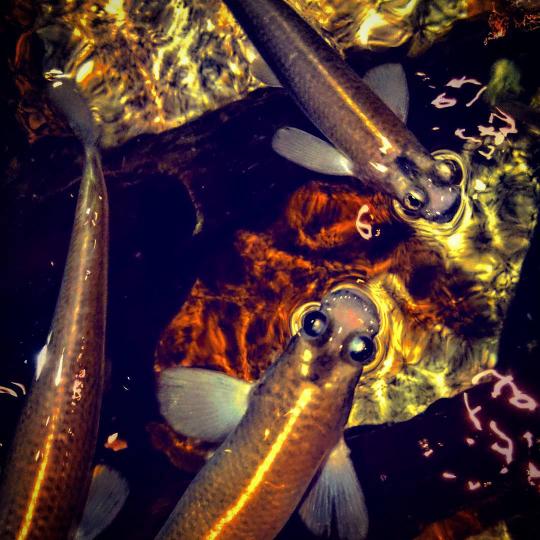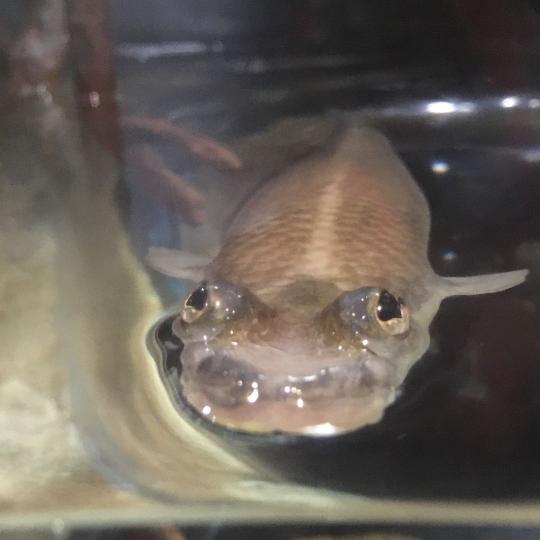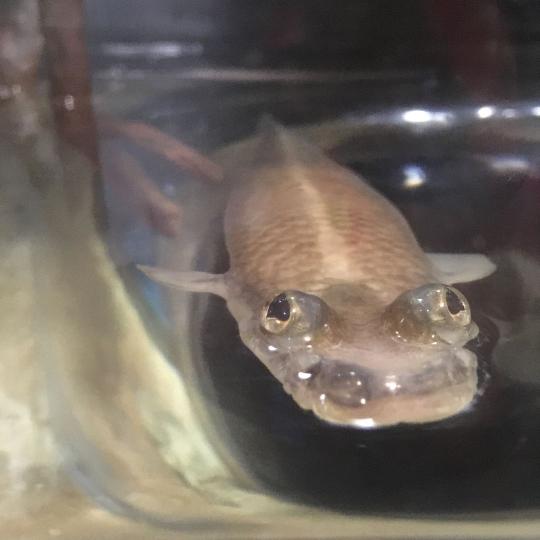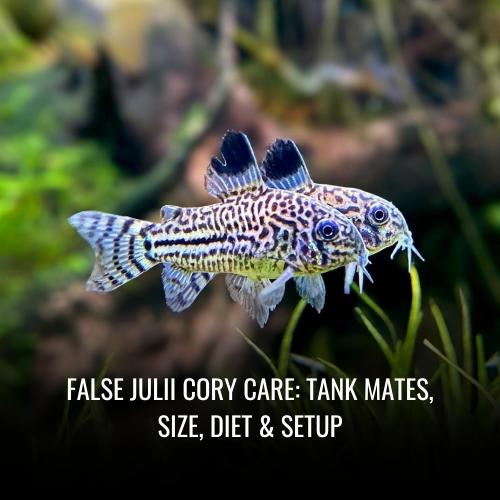These unique fish make an intriguing addition to any aquarium, showcasing not only Largescale Foureyes mesmerizing appearance but also their interesting behavior. If you’re interested in learning more about Largescale foureyes and how to care for them, this article is the perfect guide for you.
| Property | Value |
|---|---|
| name | Anableps anableps |
| Common name | Largescale Foureyes |
| Family | Anablepidae |
| Usual size in fish tanks | 12 inches (30 cm) |
| Recommended pH range | 7.0 – 8.0 |
| Recommended water hardness (dGH) | 10 – 20 |
| Recommended temperature | 72°F – 82°F (22°C – 28°C) |
| Reproduction | Livebearer |
| Origin | Central and South America |
| Temperament to its own species | Semi-aggressive |
| Temperament toward other fish species | Peaceful |
| Usual place in the tank | Top and middle levels |
| Lifespan | 4 – 6 years |
| Tank size requirement | 50 gallons or more |
| Filtration system | Strong filtration and regular water changes |
| Sexual dimorphism | Males have a modified anal fin |
| Substrate cleaning | Regular substrate cleaning and water changes |
Scientific Name
The enchanting Largescale Foureyes fish is scientifically named Anableps anableps, which stands as the most widely acknowledged species within its genus. Despite its moniker as the “Four-Eyed Fish,” the aquatic wonder is associated with varied scientific nomenclature, including Cobitis anableps, Anableps gronovii, and Anableps lineatus. These additional scientific titles reflect historical classifications and contributions by taxonomists trying to catalog the species accurately.
Within the genus Anableps, three species are currently recognized:
- Anableps anableps – Largescale Foureyes
- Anableps dowei – Pacific Foureyed Fish
- Anableps microlepis – Foureyes
Utilizing these scientific names is pivotal for scientists globally. Doing so ensures a standardized lingua franca, eliminating the perplexity interlinked with the multitude of common names. Moreover, it enables seamless communication among researchers and guarantees the precise categorization of the Largescale Foureyes within the biological community. The meticulous application of these scientific names is fundamental to the study and conservation of this unique species.
Average Size
The Largescale Foureyes, with its unique adaptation, typically measures between 6 to 8 inches (15 to 20 centimeters) in length. However, size can be significantly influenced by environmental factors, including resource availability and water quality.
In contrast, juveniles present a starkly smaller profile at just 2 to 3 inches (5 to 8 centimeters) upon birth. Their growth rate and eventual size are influenced by the conditions of their habitat, whether in the wild or captivity. Ensuring that these fish are in a favorable environment is crucial for them to reach their full size potential.
| Life Stage | Average Length |
|---|---|
| Juvenile | 2-3 inches (5-8 cm) |
| Adult Female | 6-8 inches (15-20 cm) |
| Adult Male | Up to 10 inches (25 cm) |
Overall, the average size of Largescale Foureyes is a variable trait that highlights the adaptability and resilience of these aquatic creatures in diverse environmental circumstances.
Lifespan
In optimal aquarium conditions, Largescale Foureyes may enjoy a lifespan of around 6 years, testament to their adaptability and hardiness as a species. Achieving and potentially extending this lifespan demands dedicated care and a well-maintained habitat.
Several factors play a crucial role in the longevity of these intriguing fish. For starters, maintaining high water quality is paramount. A diet rich in nutrients, mimicking their natural preference, contributes greatly to their health and vitality. Moreover, choosing compatible tank mates minimizes stress, encouraging a peaceful and conducive living environment.
Here’s a look at how to maximize the lifespan of Largescale Foureyes:
| Factor | Contribution to Lifespan |
|---|---|
| Water Quality | Prevents stress and disease, promoting longevity |
| Diet | Provides essential nutrients for health |
| Tank Mates | Reduces stress from aggression and competition |
In captivity, with careful attention to these aspects, these remarkable fish may even surpass their typical lifespan observed in the wild.
Natural Habitat
The Largescale Foureyes, scientifically known as Anableps anableps, are native to the warm coastal regions surrounding the tropical western Atlantic Ocean, including the southern Caribbean Sea. Their geographic range extends from Trinidad and Venezuela to the Amazon River’s delta in Brazil.
Come low tide, Largescale Foureyes form impressive shoals, sometimes in the hundreds, with adult females leading and males closely pursuing. These gatherings are not just for social interaction but serve as a defensive mechanism against predators.
An intriguing aspect of their existence is their diverse diet, feeding on anything from insects to small fish and various invertebrates. Their appetite is omnivorous, including:
- Insects
- Small crabs
- Diatoms
- Gammarid amphipods
- Snails
- Mussels
- Worms
This dietary adaptability supports their survival and flourishing in complex and ever-changing ecosystems.
Appearance
One of the most remarkable features of the Largescale Foureyes (Anableps anableps) is their unique eye structure. They possess a band of tissue that divides each eye horizontally, granting them the extraordinary ability to see above and beneath the water’s surface simultaneously. This adaptation is crucial for their terrestrial feeding habits, as it helps them spot prey like terrestrial insects — a behavior also seen in the Archer Fish.
Their bodies are elongate and slim, colored in shades that vary from olive-green to brown. Meanwhile, their undersides boast a silvery sheen. When light hits at certain angles, the lateral band running along their sides casts an iridescent glow, adding a touch of dazzle to their appearance.
Here’s a quick glance at their physical traits:
| Feature | Description |
|---|---|
| Body Shape | Elongate, slender |
| Color | Olive-green to brown; silvery below |
| Distinctive Eyes | Divided for dual vision; termed “Foureyes” |
| Fins | Lyre-shaped anal fin; dorsal fin near tail |
| Size | Can grow up to 15 centimeters in length |
| Scales | Small and round |
Their small, top-positioned mouths are adept for snapping up surface-level snacks, and the lyre-shaped anal fin, along with the posteriorly-placed dorsal fin, accentuates their unusual silhouette. Covered in diminutive, round scales, the Largescale Foureyes are perfectly designed for life at the water-air interface.
Behavior & Temperament
Largescale foureyes, known scientifically as Anableps anableps, exhibit fascinating behaviors and a calm temperament in their natural aquatic environments. These intriguing creatures boast a remarkable eye adaptation, allowing them to monitor the happenings both above and below the waterline— key to their survival and daily activities.
Given their non-aggressive nature towards conspecifics, they’re considered peaceful dwellers within the aquatic community, granted their environmental needs are sufficiently met. Now, let’s delve into the specifics of their behavior and social tendencies.

Are Largescale foureyes Fin Nippers?
Despite their striking appearance and unique eyesight, Largescale foureyes are not typically known to be fin nippers. Their feeding strategy is geared towards catching invertebrates and other delicacies that float on the water’s surface—not the fins of other fish. With a peaceful disposition towards members of their own species, Largescale foureyes display behaviors that reflect their preference for surface feeding over nipping at the fins of tank mates.
Here, the bounty of their natural habitat provides ample sustenance, diminishing the impulse to nip:
| Trait | Influence on Fin Nipping Behavior |
|---|---|
| Surface Feeding | Focus on above-water prey; less interaction with fish fins |
| Peaceful Temperament | Coexist without displaying fin nipping tendencies |
| Shoaling Nature | Engage with group members rather than attacking |
Are Largescale foureyes Aggressive To Each Other & Other Fish?
Largescale foureyes typically enjoy a peaceful coexistence with their kin, showcasing a preference to swim in groups rather than engage in conflict. Aggressive encounters are rare within the species itself, as they naturally tend towards schooling behavior.
However, this peaceful stance might shift when it comes to other, smaller fish species where they can become somewhat territorial—especially if food is at stake or if their living space doesn’t meet their requirements.
| Factors Leading to Aggression | Recommendations to Minimize Aggression |
|---|---|
| Competition for Food | Ensure ample feeding to avoid competition |
| Overcrowded Space | Provide enough space and hiding spots |
| Mismatched Tankmates | Carefully select compatible species |
Are Largescale foureyes Friendly To Each Other & Other Fish?
When it comes to social interactions within their species, Largescale foureyes are friendly and often exhibit shoaling behavior. They prefer swimming in groups and are known for their gregarious nature, which allows them to comfortably coexist in a communal setting.
Their distinctive visual system not only aids in their survival but also in navigating social dynamics with ease. Smaller fish might sometimes face predatory advances from Largescale foureyes, but with suitable-sized tankmates, a harmonious aquatic community is certainly achievable.
Are Largescale foureyes Schooling Fish?
Indeed, Largescale foureyes are recognized for their schooling behavior in their native habitats, which include the diverse ecosystems of fresh and brackish waters along coastlines and mangroves.
These fish find safety and efficiency in numbers, whether for protection against predators, mating, or collectively scouring for food. Such social inclinations are an intrinsic part of their behavior and contribute to their propensity to live and thrive as communal creatures.
Can You Have Just One Largescale foureyes In The Tank?
While it is physically possible to keep a solitary Largescale foureyes in a tank, it is not advisable due to the potential adverse effects on their mental and emotional well-being. Isolation can lead to decreased activity, heightened stress, and even aggression — a stark contrast to the animated and cohesive behavior observed in groups.
Do Largescale foureyes Need To Be In Groups?
The collective nature of Largescale foureyes underscores the necessity of group living for these fish. Being shoaling by nature, they depend on the presence of their kin for social stimulation and security, making them more likely to display their natural behaviors when in a group setting. The benefits of group living for Largescale foureyes extend beyond mere companionship:
| Benefits of Group Living | Description |
|---|---|
| Reduced Stress | The presence of peers helps lessen individual fish stress |
| Enhances Natural Behavior | Group living encourages feeding and breeding behaviors |
| Mental Stimulation | Interaction within a group offers enrichment and activity |
It is clear that the Largescale foureyes thrive best when in the company of their own kind, favoring a socially rich and environmentally stable ecosystem.
Food & Diet
Largescale foureyes, with their unique binocular vision, are well-equipped for a diet that extends beyond the water’s surface. These carnivorous creatures have adapted their feeding habits to primarily include invertebrates, with a particular emphasis on terrestrial insects, ensuring a high protein intake vital for their health and well-being.

Do Largescale foureyes Eat Algae?
Largescale foureyes are not inclined to consume algae as a food source. Their feeding behaviors and physical adaptations are tuned to focus on invertebrates that make an appearance on the water surface. Research shows that these fish are adept at terrestrial feeding, thanks to their split eyes, enabling them to spot and prey on small organisms rather than grazing on algae.
Do Largescale foureyes Eat Shrimp?
Shrimp are indeed on the menu for Largescale foureyes. These crustaceans constitute a part of the varied invertebrates they hunt for sustenance. Within their natural habitat and in an aquarium setting, small live or frozen shrimp can serve as a nutritious part of their diet, resembling the natural diet of these fish.
Do Largescale foureyes Eat Bloodworms?
Bloodworms are among the natural dietary components of Largescale foureyes. Floating on the water’s surface, these larvae are easily targeted by the fish’s remarkable vision, which allows them to feed on creatures both submerged and airborne. For aquarium enthusiasts, including bloodworms in the diet of Largescale foureyes helps parallel their natural feeding tendencies and supports their nutritional needs.
Do Largescale foureyes Eat Mosquito Larvae?
Feasting on mosquito larvae is intrinsic to the diet of Largescale foureyes. In their wild habitats, these fish are opportunistic when it comes to the larvae, which are a staple. Offering mosquito larvae to Largescale foureyes within the confines of an aquarium is an excellent way to mimic their natural food intake habits and ensure a balanced diet.
Do Largescale foureyes Eat Planaria?
The diet of Largescale foureyes, rich in invertebrates, includes planaria—a type of flatworm frequently found in aquatic settings. These creatures, along with others that settle on the water surface, form a significant part of what these fish consume. Planaria, present in a set-up aquarium, would likely be a natural and consumed food source for Largescale foureyes.
Do Largescale foureyes Eat Plants?
Contrary to a herbivorous diet, Largescale foureyes are primarily carnivores. They have evolved to hunt live prey including insects and aquatic invertebrates, displaying no inclination towards feeding on plants. Their specialized eyes and hunting behavior further reinforce their preference for a diet devoid of plant matter.
Sexing: Male vs Female
When distinguishing between male and female Largescale foureyes, several key differences are apparent. Male Largescale foureyes exhibit a distinct adaptation: their anal fin transforms into a gonopodium, a tube-like, intromittent organ used for internal fertilization. This specialized fin is a clear indicator of a male fish. Contrastingly, female Largescale foureyes lack a gonopodium and display a notably larger size when fully mature, aiding in visual sex identification.
Fascinatingly, these fish also present a unique lateralized mating system. Males and females pair based on the side of their gonopodium or receptive organ. Specifically, left-sided males will mate with left-sided females, and the same goes for right-sided pairs. This precise lateralization in their mating strategy ensures successful copulation and fertilization. As livebearers, the presence of the gonopodium in males is crucial for the continuance of their species.

Largescale foureyes Tank Mates
In selecting the perfect tank mates for Largescale foureyes, it’s essential to prioritize peaceful, brackish water-loving companions. These unique fish are amiable, but caution is advised as they can be territorial towards smaller tank inhabitants. Optimal companions include:
- Mollies
- Guppies
- Swordtails
- Other non-aggressive livebearers
A serene living environment free from fin-nippers and hostile species is key for the wellbeing of Largescale foureyes. Therefore, avoid fish with aggressive tendencies to prevent undue stress or harm.
Largescale foureyes are known to exhibit shoaling behavior, requiring ample space to swim. Therefore, a spacious community tank setup is necessary for these fish to thrive when housed with others of a compatible size and disposition. Remember that a harmonious underwater community is built on the foundation of similar size, temperament, and water condition preferences among its members.
Aquarium Setup
Creating the perfect habitat for Largescale Foureyes (Anableps anableps) in captivity involves replicating elements of their brackish water environments to make them feel at home. Their unique ability to feed on terrestrial insects and their use of the water’s surface warrants special attention when designing their aquarium. Here’s how to set up an aquarium that caters to their distinctive needs while ensuring their health and happiness.

Ideal Tank Size
When it comes to housing Largescale Foureyes, space is a luxury they can’t do without. A minimum tank size of 65 gallons is essential for a group of juvenile foureyes, allowing enough room for them to swim and interact. As they grow, these elongate fish will need even more space to thrive, necessitating a 6-foot long tank that holds 125 gallons or more for fully-grown adults. This space not only provides ample swimming room but prevents territorial disputes that can arise in crowded conditions.
Tank Essentials for Largescale Foureyes:
| Feature | Specification |
|---|---|
| Minimum Tank Size | 65 gallons (juveniles) |
| Required Tank Length | 6 feet (adults) |
| Tank Volume | 125 gallons+ (adults) |
Ideal Water Parameters
Water quality is paramount for Largescale Foureyes, calling for specific conditions that mirror their natural habitats. A specific gravity between 1.005-1.015 is ideal, signifying the brackish nature of their environments. The water temperature should be kept warm, between 75-82°F (24-28°C), with a pH level ranging from 7.5 to 8.5 to align with the slightly alkaline conditions they are accustomed to.
Regular partial water changes—at 20% every two weeks—are crucial to manage nitrates and ensure continued water clarity and quality. The fish’s sensitivity to copper requires water tests to keep copper levels negligible, preventing toxicity.
Water Parameter Range for Largescale Foureyes:
| Parameter | Ideal Range |
|---|---|
| Specific Gravity | 1.005-1.015 |
| Temperature | 75-82°F (24-28°C) |
| pH Level | 7.5-8.5 |
| Ammonia | 0 ppm |
| Nitrates | < 40 ppm |
| Copper | Minimal/None |
Filtration
The role of filtration in an aquarium housing Largescale Foureyes cannot be overstated. A robust biological filtration system keeps ammonia levels at bay, ensuring the breakdown of waste efficiently. Incorporating mechanical filtration helps to capture solid waste, while chemical filtration is key in removing toxins. A moderate water flow is desired, reflecting the gentle movements they would experience in tidal flats and estuaries, all the while maintaining high oxygen levels.
Proper filtration does more than just keep the water clear; it also sets the foundation for a healthy aquatic ecosystem where the Four-Eyed Fish can flourish.
Key Aspects of Filtration for Largescale Foureyes:
- Reliable biological, mechanical, and chemical filtration
- Moderate water flow mimicking natural environments
- High oxygenation levels
Lighting
The lighting in the Largescale Foureyes habitat should emulate the soft, dappled sunlight of their natural coastal environments. Low to moderate light intensity is preferable, which can be achieved through a combination of subdued natural light and adjustable LED aquarium lighting. Ensure the light setup allows for gradual transitions between bright and dim, simulating the natural rise and set of the sun, while avoiding overly bright conditions that might stress these sensitive fish.
Guidelines for Aquarium Lighting for Largescale Foureyes:
- Subdued to moderate lighting intensity
- Combination of natural and artificial light
- Adjustable lighting systems for natural transitions
- Avoidance of overly bright or direct lighting
By following these guidelines for tank size, water parameters, filtration, and lighting, aquarists can create a thriving ecosystem for the fascinating Largescale Foureyes, allowing them to exhibit their unique patterns in feeding and behavior.
Common Possible Diseases & Prevention
Largescale Foureyes (Anableps anableps) are particularly susceptible to bacterial skin infections, especially when transitioning into a new aquarium environment. To safeguard against this, a meticulous acclimation process is imperative for their initial introduction. These graceful swimmers thrive on a diet abundant in proteins, which fortifies their immune system and aids in averting ailments such as stunted growth or spinal issues.
Preventative Measures:
- Acclimation: Gradual introduction into the tank to avoid shock.
- Nutrition: A well-rounded, protein-focused feeding regimen.
- Environment: An aquarium that echoes their endemic habitat reduces stress.
Embedding new fish, foliage, substrates, or tank accessories accompanies the risk of disease introduction; therefore, scrupulous sanitation and quarantine practices are essential. The equilibrium of the habitat must be preserved with diligent care to avoid any health adversities.
| Prevention Tips | Actions to Implement |
|---|---|
| Tank Cleanliness | Regular maintenance and cleaning |
| Quarantine | Isolate new additions before introduction |
| Diseased Fish Isolation | Separate sick fish promptly to prevent spreading |
Combining cleanliness, balanced nourishment, and considered acclimation is the quintessence of disease prevention for Largescale Foureyes.
Breeding Largescale foureyes In Aquariumis
To the delight of beginner breeders, Largescale Foureyes is moderately straightforward to breed when healthy, adult, and sexually compatible. Mating often results in sizable fry, which proves easy to care for due to their resilience — special breeding equipment is typically not required.
It’s crucial to note that these fish are social creatures that flourish in groups of six or more, owing to their schooling nature. Isolated Foureyes may experience stress, which can hinder breeding success.
As onesided livebearers, they deliver live young rather than laying eggs, streamlining the mating process within a suitable environment. Keeping a proper ratio of males to females can further encourage breeding activity. Their reproduction not only adds liveliness but enhances the biodiversity within a community tank.
Essential Elements for Breeding Largescale Foureyes:
| Component | Breeding Requirement |
|---|---|
| Group Size | Minimum of six for a positive social structure |
| Tank Environment | Ample space and a secure, stable habitat |
| Compatibility | Sexually mature and compatible mates |
In summary, to achieve successful breeding of Largescale Foureyes, prioritizing their social needs, creating a secure habitat, and matching healthy adults are key steps that lead to vibrant offspring and a dynamic aquarium community.
Are Largescale foureyes Easy To Keep?
Largescale foureyes are renowned for being quite easy to keep, which is excellent news for aquarists of all skill levels. They have a remarkable capacity to adapt to various aquatic environments, reflecting their natural habitat that ranges from freshwater rivers to brackish coastal mudflats and mangroves of South America. Their peaceful demeanor and preference for shoaling make them low-maintenance companions well-suited for beginners.
In terms of their diet, Largescale foureyes are far from finicky, willing to consume a range of foods. They can be fed commercial flakes and pellets, as well as live or frozen delicacies, ensuring their dietary needs are easily met in a domestic aquarium. Caretakers can appreciate the lack of stringent feeding protocols necessary for these adaptable fish.

Are Largescale foureyes Sensitive To Water Changes?
Maintaining stable water conditions is crucial for the welfare of Largescale foureyes. Originally hailing from consistent freshwater and brackish water environments, they can be sensitive to sudden shifts in water parameters. Factors such as temperature, pH, and hardness, when altered abruptly, can inflict stress upon these fish, with potential negative consequences for their health.
Sudden changes in water quality, especially spikes in ammonia and nitrite levels, can be particularly detrimental for Largescale foureyes. These waterborne toxins can swiftly become a threat, highlighting the need for gradual acclimatization to new tank conditions. Consistent monitoring and a rigorous maintenance schedule, keeping the water temperature within a comfortable 23 – 28°C (73.4 – 82.4°F), are paramount to minimizing the impact of water changes on these sensitive fish.
Are Largescale foureyes Sensitive To Ammonia?
The health and well-being of Largescale foureyes are critically affected by the presence of ammonia in their environment. As a byproduct of fish waste and decomposing food, ammonia can rapidly accumulate to dangerous levels. Even trace amounts of ammonia can inflict harm, leading to gill damage, respiratory complications, and in severe cases, fatality.
Handling ammonia sensitivity involves attentive monitoring through regular water testing. Steps to combat elevated ammonia levels include rigorous tank cleaning, avoiding overfeeding, and ensuring the filtration system is properly functioning. Careful maintenance of their habitat is key to protecting Largescale foureyes from the damaging effects of toxic ammonia build-up.
Are Largescale foureyes Sensitive To Copper?
Like many aquatic species, Largescale foureyes exhibit a particular sensitivity to copper. High levels of copper in aquarium water can induce toxicity, stress the fish, and lead to gill damage, which can compromise their overall health. Since copper may be present in certain water sources or treatments, exposure to even minimal amounts should be carefully controlled.
Copper impacts the delicate balance of a fish’s ability to regulate its internal environment and can have serious implications for health if neglected. As such, any aquarist keeping Largescale foureyes must remain vigilant, routinely test for copper levels, and judiciously use copper-based products to ensure a safe, conducive habitat for these sensitive creatures.



